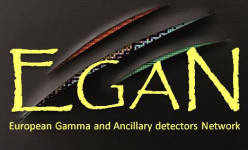Speaker
Jan Diriken
(IKS - KU Leuven)
Description
The interest in the structure of nuclei around 68Ni has been triggered long ago by the observation of the high excitation energy of the first 2+ in this nucleus [1]. Combining this observation with the fact that a minimum is reached in the systematic of B(E2;2+ -> 0+)-values at N=40 in the neutron rich nickel chain has lead to interpretations in terms of a harmonic oscillator subshell closure resulting in extensive theoretical studies [2]. The excitation spectrum of odd mass nuclei in the direct neighborhood of closed shells is usually governed by single particle excitations. One-neutron transfer reactions are a useful tool to fix spins and parities of excited states and determine spectroscopic factors which can be compared to shell model predictions. Recent large scale shell model calculations have shown the sensitivity of certain nuclear parameters in this region to the size of the N=40 and N=50 shell gaps [3]. By measuring effective single-particle energies these shell gaps can be fixed and serve as valuable input for various nuclear models. In this case the excitation spectrum of 67Ni was studied by performing the 66Ni(d,p)67Ni reaction in inverse kinematics with an energy of 3 MeV/u at the REX-ISOLDE radioactive ion beam facility in CERN using the MINIBALL setup in combination with the T-REX particle detection array [4]. The extracted angular distributions of the protons -based on particle-gamma coincidences- can be compared with DWBA calculations in order to determine spin and parity of the excited states as well as spectroscopic factors. Population of levels with excitation energy up to 6 MeV has been observed, an preliminary angular distributions indicate that levels above the N=50 shell gap are populated. An overview of the latest results will be given, including preliminary angular distributions. [1] R. Broda et al. Phys.Lett.B 113, 279 (1982) [2] O. Sorlin et al. Phys.Rev.Lett. 88, 092501 (2002) [3] K. Langanke et al. Phys.Rev.C 67, 044314 (2003) [4] V. Bildstein et al. Prog.Part.Nucl.Phys 59, 386 (2007)
Author
Jan Diriken
(IKS - KU Leuven)
Co-authors
Prof.
Andrei Andreyev
(University of West-Scotland)
Prof.
Athena Pakou
(University of Ioannina)
Dr
Dennis Muecher
(TU Munich)
Prof.
Georgi Georgiev
(CNRS Orsay)
Dr
Iain Gerard Darby
(Katholieke Universiteit Leuven)
Ms
Jytte Elseviers
(Katholieke Universiteit Leuven)
Dr
Kathrin Wimmer
(MSU - Michigan)
Prof.
Mark Huyse
(Katholieke Universiteit Leuven)
Mr
Michael Seidlitz
(IKP Cologne)
Prof.
Nikolaos Patronis
(Katholieke Universiteit Leuven)
Prof.
Piet Van Duppen
(Katholieke Universiteit Leuven)
Prof.
Reiner Kruecken
(TU Munich)
Prof.
Riccardo Raabe
(Katholieke Universiteit Leuven)
Dr
Thomas Roger
(Katholieke Universiteit Leuven)
Dr
Vinzenz Bildstein
(Guelph University)

